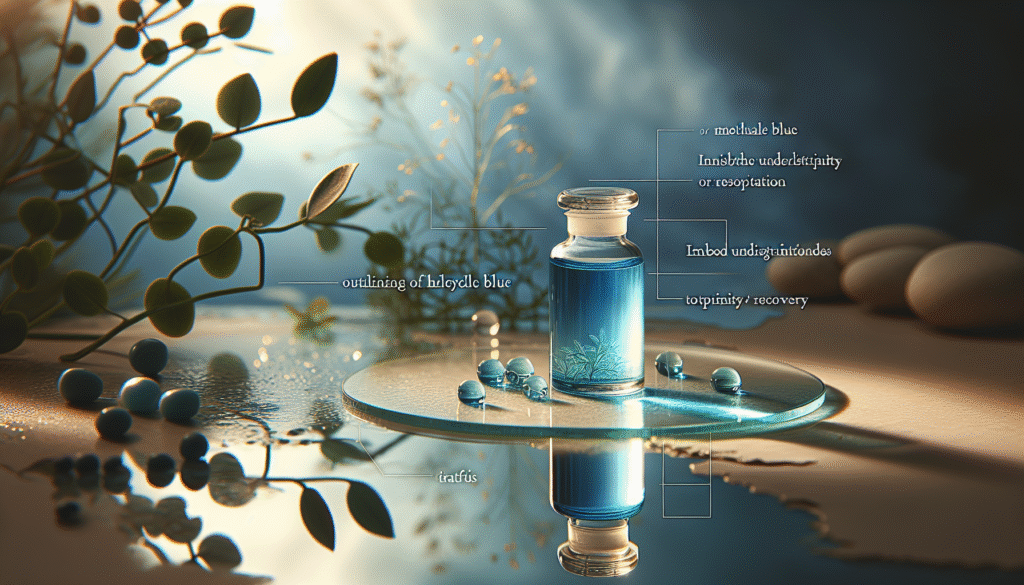
Have you ever wondered if a centuries-old dye could hold the key to alleviating depression? Methylene Blue, initially used for dyeing fabrics and as an antiseptic, has piqued the interest of researchers for its potential role in mental health treatment. This article will dissect the relationship between Methylene Blue and depression, reviewing its history, pharmacology, and emerging research findings, along with the potential implications for your mental health.

Understanding Depression
Before delving into potential treatments, it is crucial to comprehend what depression is. Depression is not merely feeling sad or down; it is a complex, multifaceted mental health disorder characterized by persistent feelings of sadness, loss of interest or pleasure, and an array of physical and cognitive symptoms.
Signs and Symptoms
Identifying the signs of depression can be challenging, given its varied presentation. Common symptoms include:
- Persistent Sadness: A deep, lingering feeling of sadness or emptiness.
- Loss of Interest: A noticeable decline in enjoyment or interest in previously pleasurable activities.
- Fatigue: A recurring sense of exhaustion that rest and sleep do not alleviate.
- Changes in Appetite: Significant weight loss or gain due to changes in appetite.
- Sleep Disturbances: Insomnia or hypersomnia that disrupts daily functioning.
- Cognitive Impairments: Difficulty in focusing, making decisions, or remembering information.
- Suicidal Thoughts: Preoccupation with death or thoughts of self-harm.
The Importance of Treatment
Understanding and treating depression is essential, as it can significantly impair an individual’s quality of life. Although numerous treatments are available, including therapy and medications, there exists a persistent search for alternative therapies that might exhibit fewer side effects or provide quicker relief.
The Science of Methylene Blue
Methylene Blue, known for its vibrant blue color, has a rich history that extends beyond the realm of coloring agents. Initially synthesized in 1876, it has been used in various medical applications, including as an antidote for certain types of poisoning and to treat certain infections. Its potential effects on the central nervous system have sparked interest in its use for treating neurodegenerative diseases and mood disorders.
Mechanism of Action
To fully grasp how Methylene Blue could potentially aid in alleviating depression, it’s essential to explore its pharmacological properties.
-
Mitochondrial Function: Methylene Blue has been found to improve mitochondrial function and increase cellular energy production. Mitochondria are the powerhouses of cells, and their dysfunction has been implicated in mood disorders.
-
Neurotransmitter Modulation: This compound influences several neurotransmitter systems, primarily serotonin and dopamine, both of which are critical in regulating mood.
-
Antioxidant Properties: Methylene Blue exhibits antioxidant effects that could reduce oxidative stress within the brain, a factor believed to worsen mood disorders.
-
Neuroprotection: Some studies suggest that Methylene Blue may offer neuroprotective benefits, helping to safeguard brain cells and potentially enhancing cognitive function.
Clinical Research on Methylene Blue and Depression
A number of studies have explored the efficacy of Methylene Blue as a treatment for depression. Research on its impact has steadily increased, though it remains limited compared to more conventional treatments.
Early Animal Studies
Animal studies have shown promise. In one study, Methylene Blue administration led to antidepressant-like effects in a rodent model. The observed increase in serotonin levels and subsequent behavioral improvements were noteworthy.
Human Trials
Human trials are still in their nascent stages. Recent research indicates possible benefits of Methylene Blue in treating major depressive disorder. One clinical trial demonstrated that participants who received Methylene Blue showed significant improvement in depressive symptoms compared to a placebo group. However, the sample size was small, and more extensive trials are needed to confirm these findings.
| Study | Sample Size | Findings |
|---|---|---|
| Rodent Model | 30 | Increased serotonin, reduced depressive behavior |
| Human Trial (placebo-controlled) | 50 | Improved depressive symptoms vs. placebo |
Safety and Side Effects
Whenever considering a new treatment, weighing the potential benefits against the risks and side effects is necessary.
- Common Side Effects: Mild side effects of Methylene Blue can include nausea, headache, and dizziness.
- Serotonin Syndrome: There exists a risk—although minimal—of serotonin syndrome, particularly if taken with other serotonergic medications.
- Long-term Use: The long-term effects of Methylene Blue use for depression are not well understood and warrant careful consideration.
Combining Methylene Blue with Established Treatments
One intriguing possibility is utilizing Methylene Blue as an adjunct to existing treatment modalities, such as antidepressants and psychotherapy. Combining treatments can sometimes yield better results than using a single approach.
Potential Benefits of Combination Therapy
- Synergistic Effects: Methylene Blue’s action on neurotransmitter systems could complement serotonergic antidepressants, enhancing their efficacy.
- Rapid Action: Traditional antidepressants may take weeks to demonstrate effects, whereas Methylene Blue may offer more immediate relief of symptoms.
- Reducing Side Effects: By lowering the necessary dose of conventional medications, Methylene Blue may help mitigate adverse effects often experienced by individuals on standard antidepressants.
| Combination Therapy | Potential Advantages |
|---|---|
| Methylene Blue + SSRIs | Enhanced serotonin levels, quicker relief |
| Methylene Blue + Therapy | Improved cognitive function alongside emotional support |
Personal Experiences and Case Studies
While clinical research provides valuable insights, anecdotal evidence can be profoundly compelling. Individuals who have experimented with Methylene Blue have reported varying experiences.
User Testimonials
Some users have described significant mood improvements after incorporating Methylene Blue into their treatment regimen. For instance, one anecdotal account involved an individual with treatment-resistant depression who noted a marked enhancement in energy and mood stability after starting Methylene Blue treatment.
Broader Patient Perspectives
However, it’s essential to acknowledge that not everyone experiences beneficial effects. Several individuals have reported no noticeable difference, emphasizing the need for personalized approaches to treatment.

Conclusions and Future Implications
As you consider the potential of Methylene Blue in treating depression, it’s essential to remain cautious and informed. Although the initial findings are promising, there remains a substantial amount of research needed to validate its efficacy and safety.
The Outlook on Methylene Blue Research
The future of Methylene Blue as a treatment for depression appears cautiously optimistic. Researchers are currently exploring more extensive clinical trials, which could provide valuable data on its effectiveness, dosing regimens, and long-term safety.
The Role of Patients and Clinicians
For individuals navigating depressive disorders, having conversations with healthcare providers about Methylene Blue could be worthwhile, especially considering the need for novel therapies in treatment-resistant cases. Your mental health is paramount, and informed decision-making should guide your treatment path.
In summary, while Methylene Blue shows potential as an adjunct treatment for depression, it is crucial to rely on established therapeutic avenues until further evidence supports its widespread application. Engage in an informed dialogue with your healthcare provider to navigate your treatment options thoughtfully.
Given that mental health conditions vary widely among individuals, remaining receptive to emerging treatments can foster hope and provide alternative avenues for recovery. As research evolves, it is essential to stay informed and actively participate in your treatment journey. Remaining vigilant about developments in psychiatric medicine may yield beneficial insights that ultimately improve your well-being.